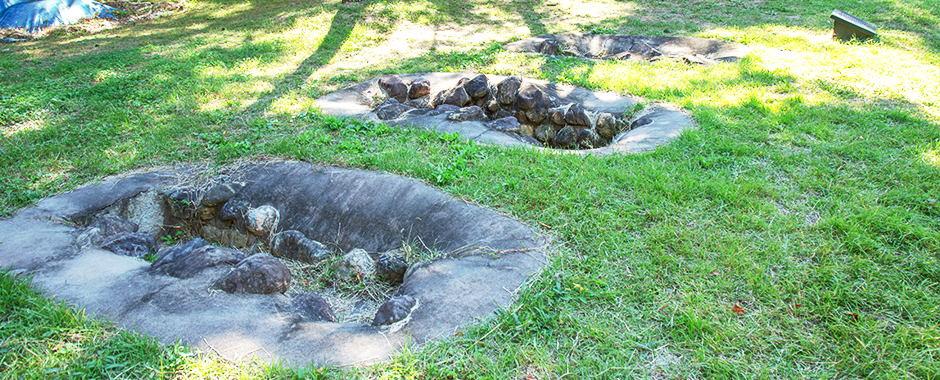Outdoor Exhibition
The museum's garden features a five-story stone pagoda (Korean Treasure 357) from Jeongdosa Temple, as well as a stone pagoda and other stone structures from the Unified Silla period. Strolling on the path behind the museum, visitors can examine dolmens and a housing site from the Bronze Age, as well as a kiln from the Three Kingdoms period.
Featured Items
Five-story Stone Pagoda of Jeongdosa Temple Site
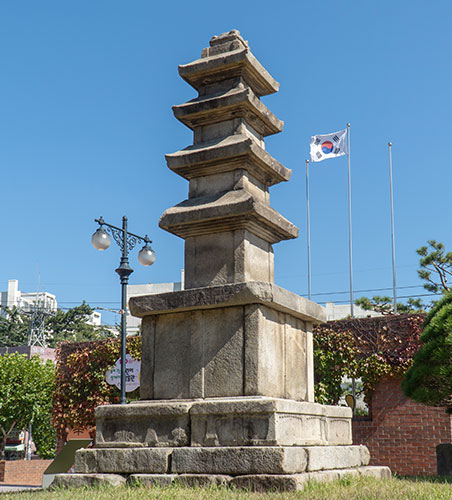
This stone pagoda, originally located in the ancient site of Jeongdosa Temple in Yangmok-myeon, Chilgok-gun, Gyeongsangbuk-do, was relocated to Gyeongbokgung Palace in 1924, before it was finally housed in the Daegu National Museum. The stone pagoda, created in early Goryeo, inherits the style of Silla pagodas. The pagoda is missing its roof stone, and the round finial base currently rests directly on its main body. The inscription found on the upper tier of the platform indicates that the pagoda was erected in 1031 (the 22nd year of Goryeo King Hyeonjong's rule: 11th Taiping Year) to pray for the safety and prosperity of the country. For lasting preservation of the epigraph, the pagoda's façade stone slabs were replaced in 2001, with the original façade slabs stored at a separate site. The pagoda has the image of a padlocked door sculpted on the front side of its first level. Inside the pagoda, a chronicle xss-xss-xss-xss-document.ng its history was found alongside a sarira reliquary. According to this chronicle, providing the name of the pagoda, the stone edifice was constructed on the initiative of local dignitaries and residents of Yangmok-gun, then, under the jurisdiction of Gyeongsan-bu, Sangju-gye, and the construction lasted between 1019 and 1031.
Stone Column

Sosuseowon is a Confucian academy established on the site where a Buddhist temple called Suksusa had once existed as shown by a pair of stone flagpole supports (Treasure No. 59), and a pedestal and halo of a Buddha statue still remaining in it. An excavation of the site conducted in 1953 led to a discovery of several guilt-bronze Buddha images. This stone column is believed to have been used to support a lofty pavilion style building. While the upper and lower parts are hewn and trimmed, the rest is left to exhibit its original form as if to achieve a harmony with the surrounding nature.
Pensive Bodhisattva

This granite pagoda from the kingdom of Silla was once located in Baekan-dong, Dong-gu, Daegu . The base and upper part of the pagoda have been lost, so that only one section of the body and two roof stones remain. The body of the pagoda was originally in the shape of a cube, with images of the universe depicted on the sides, but the corners have been noticeably damaged. The roof section of the pagoda was carved with eaves, forming a smooth line, while the lower part features steps.
Featured Items
Kiln in Oksan-dong, Gyeongsan
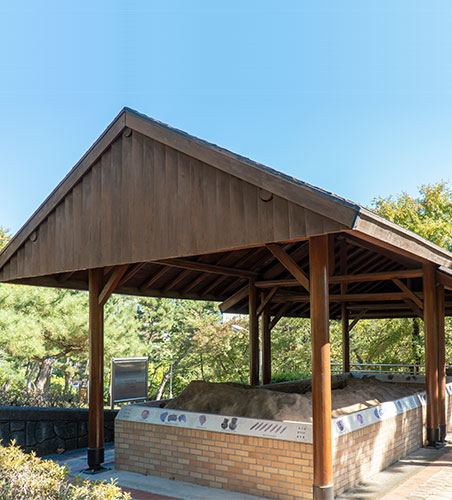
The displayed kiln represents the type of kilns that were investigated in Wuksu-dong of Daegu and Oksan-dong of Gyeonsan. It has been restored and moved to the museum. The Wuksu-dong site yielded numerous artifacts, ranging from the prehistoric period to the Joseon Dynasty, about forty of which were excavated from the slope of a mountain. Most of the excavated kilns were from the Three Kingdoms period, and they were dug partially into the ground. The kilns offer crucial evidence about the production technology and distribution process of earthenware pottery of that time.
Stone-Chamber Tomb from Seolhwa-ri, Dalseong
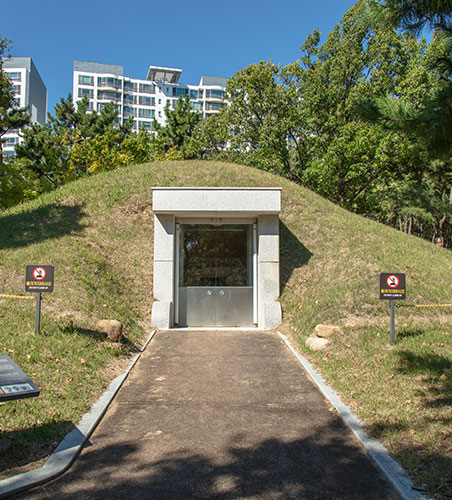
The stone-chamber tomb Is consisted of a coffin chamber, entrance passage, mound curbstones, and mound. The walls of the neolbang are built with broken stones, and a large stone slab was used as the ceiling. The tomb could be entered through a passageway on the west side. Artifacts found inside the neolbang included earrings, an iron ax, mineulsoe (thin metal plate with decorative cut edges), and an iron dagger. Several mounted dishes with bent legs were discovered in the bongbun.
A bronze-age dwelling site in Sang-dong, Daegu
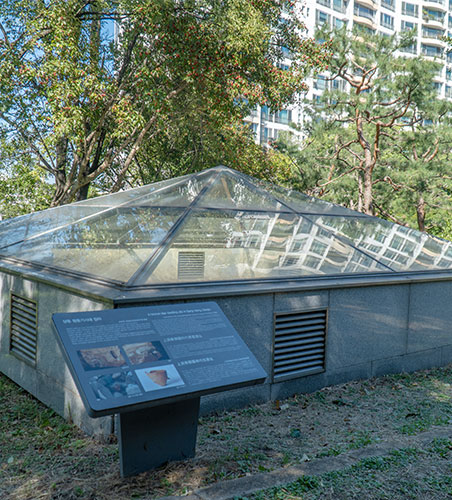
Excavated by the Gyeongsangbukdo Institute of Cultural Properties in 2006 Historic sites dating from the Neolithic Age onward are scattered here and there along the Sincheon Stream which flows through Daegu. In particular, dwelling sites and dolmens dating from the Bronze Age have been discovered on the eastern bank of the stream. This particular dwelling site was unearthed at the construction site of a building of Daegu Haany University, and was transferred to its current location for preservation due to its unique structure, being built entirely of stones from the river. The site with round-shaped base measures 4.4 by 4.2 meters, and the remaining wall structure is 44~90 cm in height. This bronze-age dwelling site is similar to those found at the Hwasun-ri Historic Site in Seogwipo, Jeju-do, Korea and the Shuangtuozi and Yangtouwa Historic Sites in Dalian, Liaoning Province, China. Researchers consider it a precious relic that sheds light on cultural exchanges between Korea and the northeastern provinces of China and the interrelations between them.
Dolmen from Bokseong-ri, Chilgok
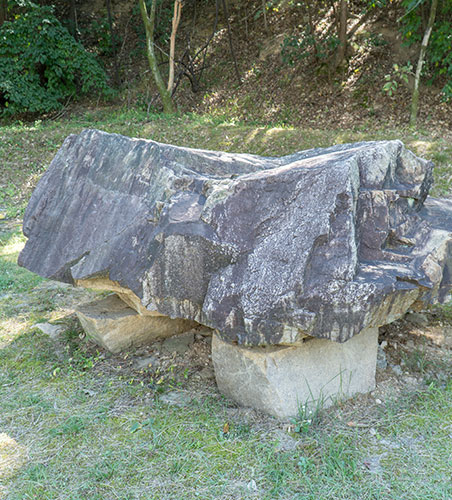
During construction of the Gyeongbu high-speed railway, a burial site featuring about twenty dolmens and stone-coffin tombs was discovered and excavated in Bokseong-ri, Chilgok-gun. After excavations, stone-coffin tombs 9 and 12, and the cover stone of stone-coffin tomb 2, were moved to Daegu National Museum. Tomb 12 was particularly unique among the graves, because it had been marked by stones that were laid out at wide distances, forming a square. Excavations at the site uncovered stone arrows, burnished red pottery, and a necklace of cylindrical jade pieces. In tomb 9, gravel was spread on the floor before the deceased was buried, but no artifacts were discovered. These burials offer crucial evidence relating to the social structure, political system, and spiritual world of prehistoric people.
Dolmen from Icheon-dong, Daegu

These stone-coffin tombs were found beneath dolmens from the Bronze Age. Although the large above-ground stones of the dolmens no longer remain, the stone plates of the buried coffins were found. The dolmens in Icheon-dong are located on riverbanks that formed naturally around the Sincheon area. These artifacts are important for teaching us about the lives of the people of the Bronze Age, as well as the geographical features of Daegu at that time.

